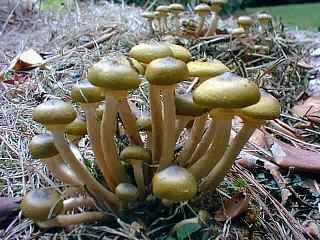Categories
Calendars
Guides
Reviews
Archive
Gallery
Articles
Ask Our Gardening Expert
How To Identify and Control
Honey Fungus
HONEY FUNGUS AMAZING FACT
IDENTIFYING HONEY FUNGUS Then you will notice white to cream honey-coloured
growths of the Honey Fungus appearing in the soil around the
base of the plant / tree - see the above picture. These growths are fan-shaped. When you pull the plant up, there will probably be dark brown
rhizomorphs which look like brown to black root-like growths
which resemble bootlaces. In
advanced cases these root-like
growths appear above the soil level. In many cases, beneath
the bark of the trunk and branches you will see white mycelium.
These form a thin creamy-white layer with a strong
mushroom smell. GO
TO THE GARDEN PEST AND DISEASE MAIN PAGE FOR CAUSE OF HONEY FUNGUS Some plants are more vulnerable to catching
Honey Fungus whilst others are relatively resistant to it. The
list below shows some common plants in these categories. It is
true that healthy plants are less likely to be attacked by Honey
Fungus compared to plants which are weak and growing in poor
conditions. PLANTS VULNERABLE TO HONEY FUNGUS
Apple
Lilac
Apricot
Privet
Birch
Peach
Cedar
Plum
Cherry
Peony
Cotoneaster
Rhododendron
Crab Apple
Rose
Currant bush (ribes)
Willow (salix)
Forsythia
Wisteria
Actinida
Kerria
Abutilon
Oak
Bamboo
Passion Flower
Beech
Phlomis
Carpenteria
Photinia
Celastrus
Pieris
Ceratostigma
Pittosporum
Cercis
Rhus (sumach)
Choisya
Romneya
Clematis
Sarcococca
Elaeagnus
Smoke Bush (Cotinus)
Fothergilla
Tamarix
Hebe
Yew (taxus)
Japanese Quince (Chaenomeles)
CONTROL OF HONEY FUNGUS For smaller areas a degree of further control
can be achieved by removing the top 60 to 90 cm (2 to 3
foot) of soil and replacing it with infection free soil. When replanting, choose plants that are
resistant to Honey Fungus (see the list above) and definitely
avoid those most susceptible to Honey Fungus (see list above).
Keep plants as healthy as possible by regular mulching and
feeding. HONEY FUNGUS - SOME OTHER FACTS How High? Can I eat Honey Fungus?
WHAT IS HONEY FUNGUS
As the name suggests Honey fungus is a fungus. It exists
primarily on dead plant material, but can also become a parasite feeding on
live plant and tree roots. It attacks a wide variety of plant
life ranging from trees to bulbs.
A mushroom colony can reach an enormous size and cover a very large area.
Recently, a variety of the honey mushroom
was identified in Oregon, USA which had
colonized 880 hectares of wood in about 2300 years (and thereby
killed a large number of trees) and its weight
exceeds that of any other living organism in the entire
world!
The first symptom you will probably notice with plants and trees
affected by Honey Fungus is general ill-health. Leaves do not
grow so well, are discoloured and fruit is small. Surprisingly,
flowering plants may produce larger than normal flowers
immediately before they die back completely. 
PESTS AND DISEASES CLASSIFIED BY PLANT
Honey Fungus is caused by direct contact with the roots of
an infected plant or tree. It is also caused by the
rhizomorphs (see above for explanation) spreading underground
from the infected plants to other healthy plants.
PLANTS WITH GOOD RESISTANCE TO HONEY FUNGUS
The is no chemical treatment for Honey Fungus. The only course
of action is to dig out all infected plants and burn them. Try
to remove as much of the root system as possible because this is
where the disease is most easily transmitted to other plants.
Does Honey Fungus Glow in the dark?
Astonishingly yes it does!
Honey fungus spores have been recorded as reaching up to
five miles high and at ground level they are present everywhere,
no matter what the time of year
Honey fungus is edible as the recipes at http://www.mssf.org/cookbook/honey.html show. But make sure that it's honey fungus you are eating and
not a poisonous mushroom or other fungus!